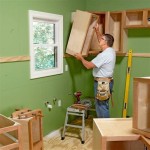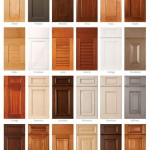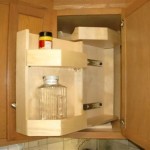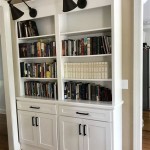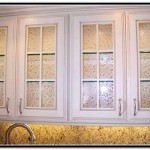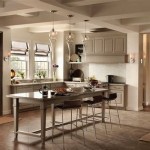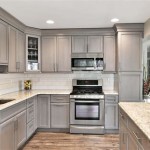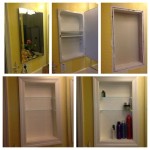What Color Goes With Dark Kitchen Cabinets?
Dark kitchen cabinets exude sophistication and create a dramatic focal point in a home. However, their boldness necessitates careful consideration when choosing complementary colors for the rest of the kitchen. The right color pairings can amplify the cabinets' elegance, brighten the space, and achieve a cohesive aesthetic. Conversely, poor color choices can lead to a cramped, gloomy, or visually jarring environment. Therefore, understanding the principles of color theory and exploring various color palettes is crucial for designing a kitchen that is both stylish and functional.
The selection of colors to complement dark kitchen cabinets extends beyond paint colors. It encompasses countertops, backsplashes, flooring, hardware, and even accessories. Coordinating these elements to create a unified and balanced design is the key to a successful kitchen renovation or redesign. The specific shade of the dark cabinets also influences the optimal color choices. For instance, cabinets with warm undertones, such as those leaning towards brown or mahogany, will pair differently than cabinets with cool undertones, such as those that are charcoal grey or navy blue.
Understanding the Undertones of Dark Cabinets
Before embarking on the color selection process, it is paramount to identify the undertones present in the dark kitchen cabinets. Undertones are the subtle hues that lie beneath the surface color and significantly impact how the cabinets interact with other colors in the room. Examining the cabinets under different lighting conditions, both natural and artificial, can help reveal these undertones. To determine the undertones, compare the cabinets to a pure black or charcoal grey object. If the cabinets appear warmer in comparison, they likely possess brown, red, or yellow undertones. Conversely, if they appear cooler, they probably have blue, gray, or green undertones.
Cabinets with warm undertones create a cozy and inviting atmosphere. They pair well with other warm colors, such as creamy whites, beige, and gold. Natural materials like wood and stone also complement warm-toned dark cabinets, enhancing their richness and depth. Conversely, cabinets with cool undertones project a more modern and sophisticated aesthetic. They harmonize with cool colors such as crisp whites, grays, blues, and greens. Stainless steel and other metallic accents complement cool-toned dark cabinets, reinforcing their contemporary appeal. Misidentifying the undertones can lead to clashing color schemes, where the chosen colors fight against the cabinets rather than enhancing them.
Furthermore, the intensity of the dark cabinet color influences the choice of complementary colors. Very dark cabinets, such as black or deep charcoal, require lighter and brighter colors to create contrast and prevent the room from feeling enclosed. Conversely, lighter shades of dark cabinets, such as navy blue or dark gray, can accommodate slightly darker and more saturated colors without overwhelming the space.
Classic Color Combinations
Several classic color combinations consistently work well with dark kitchen cabinets, providing a foundation for a timeless and elegant design. These combinations are based on established principles of color theory and have proven their enduring appeal. While personal preferences ultimately dictate the final choice, exploring these classic pairings can offer valuable inspiration and guidance.
White and Dark Cabinets: This is perhaps the most timeless and versatile combination. Crisp white walls, countertops, and backsplashes create a striking contrast against dark cabinets, brightening the space and highlighting the cabinets' architectural details. The level of contrast can be adjusted by selecting different shades of white, ranging from bright white to off-white or cream. White subway tile backsplashes are a popular choice, as they add a touch of classic charm. For a more modern look, consider using a slab backsplash in a light-colored quartz or granite.
Gray and Dark Cabinets: Gray is another neutral that pairs exceptionally well with dark cabinets, creating a sophisticated and contemporary look. The specific shade of gray should be chosen based on the undertones of the cabinets. Warm grays, with hints of brown or beige, complement cabinets with warm undertones, while cool grays, with hints of blue or green, complement cabinets with cool undertones. A light gray backsplash and countertops can create a subtle contrast, while a darker gray can create a more dramatic and moody feel. Consider incorporating textured elements, such as stone or brick, to add visual interest to the gray backdrop.
Wood Tones and Dark Cabinets: Incorporating wood tones into the design adds warmth and natural beauty to a kitchen with dark cabinets. The type of wood should be carefully selected to complement the overall aesthetic. Light-colored woods, such as maple or birch, create a bright and airy contrast against dark cabinets, while darker woods, such as walnut or cherry, add richness and depth. Wood flooring is a classic choice, but wood countertops or open shelving can also be incorporated to introduce wood tones into the design. Ensuring the wood tones complement the undertones of the cabinets is critical for a cohesive look.
Adding Pops of Color and Texture
While neutral color palettes provide a foundation for a timeless and elegant kitchen, incorporating pops of color and texture can add personality and visual interest. These accents can be introduced through various elements, such as backsplashes, hardware, accessories, and even appliances. The key is to use color and texture strategically to create a balanced and harmonious design.
Backsplashes: The backsplash is an excellent opportunity to introduce color and texture into a kitchen with dark cabinets. A colorful tile backsplash can serve as a focal point, drawing the eye and adding a touch of personality. Consider using glass tiles, ceramic tiles, or natural stone tiles in a color that complements the cabinets and other elements in the room. Patterned tiles can also add visual interest, but it is crucial to choose patterns that are not too busy or overwhelming. Textural backsplashes, such as those made from brick or stone, can add depth and dimension to the space.
Hardware: Cabinet hardware is a small detail that can make a big impact on the overall design. Choosing hardware in a contrasting color or finish can add a touch of sophistication and visual interest. For example, brass or gold hardware can add warmth and elegance to dark cabinets, while stainless steel or black hardware can reinforce a modern aesthetic. The style of the hardware should also be considered, as it can contribute to the overall style of the kitchen. For example, sleek and minimalist hardware is ideal for a contemporary kitchen, while ornate hardware is better suited for a more traditional space.
Accessories: Accessories, such as rugs, curtains, and countertop appliances, provide an opportunity to introduce pops of color and texture without making permanent changes. A colorful rug can add warmth and personality to the space, while curtains can soften the hard lines of the cabinets. Countertop appliances, such as toasters and stand mixers, can also be used to introduce pops of color. The key is to choose accessories that complement the overall color scheme and reflect the homeowner's personal style.
Lighting: The type of lighting used in the kitchen also plays a crucial role in how colors appear. Warm lighting can enhance warm colors, while cool lighting can enhance cool colors. Under-cabinet lighting can highlight the backsplash and countertops, while pendant lighting can add a touch of drama and visual interest. Consider using a combination of different types of lighting to create a layered and well-lit space. Good lighting is essential for both functionality and aesthetics.
In summary, choosing colors to complement dark kitchen cabinets requires careful consideration of undertones, color theory, and personal preferences. By understanding the principles outlined above and exploring various color palettes, it is possible to create a kitchen that is both stylish and functional, reflecting the homeowner's unique taste and enhancing the overall aesthetic of the home. Remember to test paint samples in the actual kitchen space under different lighting conditions before making a final decision. Utilizing design tools and consulting with a professional interior designer can also assist in achieving the desired result.

16 Amazing Color Scheme Ideas For Kitchens With Dark Cabinets

11 Ideas For Dark Kitchen Cabinets Paintzen

11 Ideas For Dark Kitchen Cabinets Paintzen

16 Amazing Color Scheme Ideas For Kitchens With Dark Cabinets

The Best Color To Paint Your Kitchen If You Have Dark Cabinets

Choosing The Best Paint Colors For A Kitchen With Dark Cabinets Five Star Painting

Best Paint Colors For Kitchens With Dark Cabinets Jenna Kate At Home

16 Amazing Color Scheme Ideas For Kitchens With Dark Cabinets

16 Amazing Color Scheme Ideas For Kitchens With Dark Cabinets

11 Ideas For Dark Kitchen Cabinets Paintzen
Related Posts

